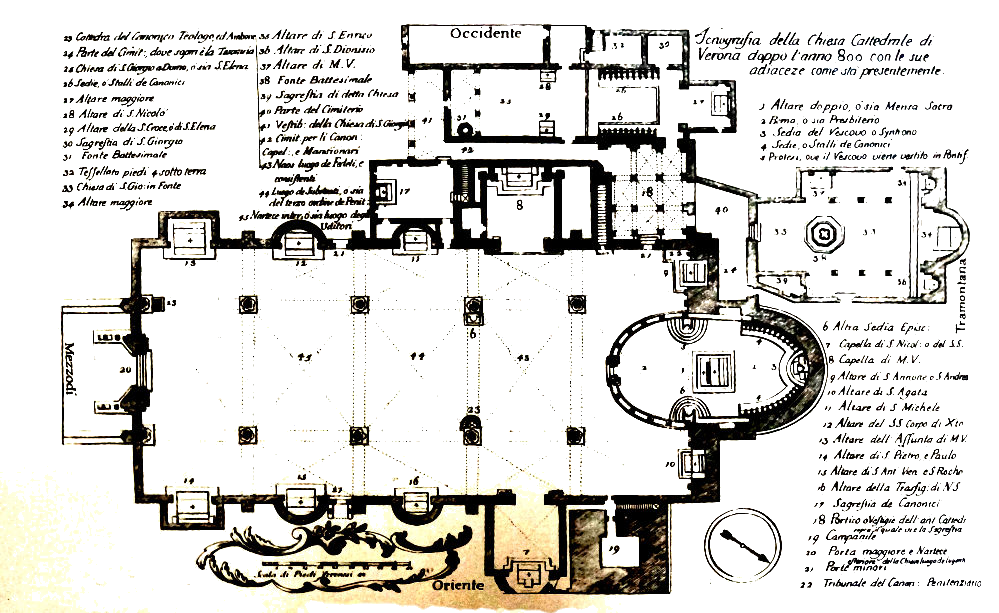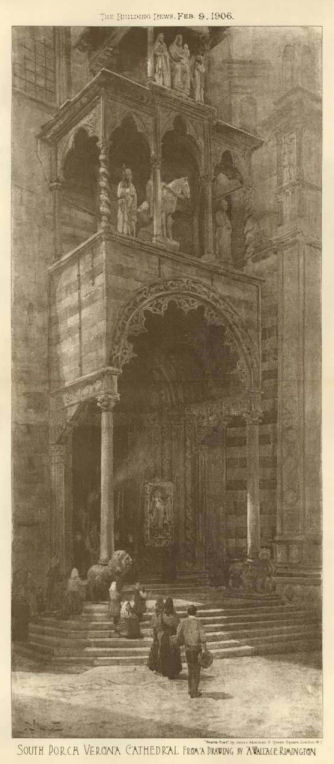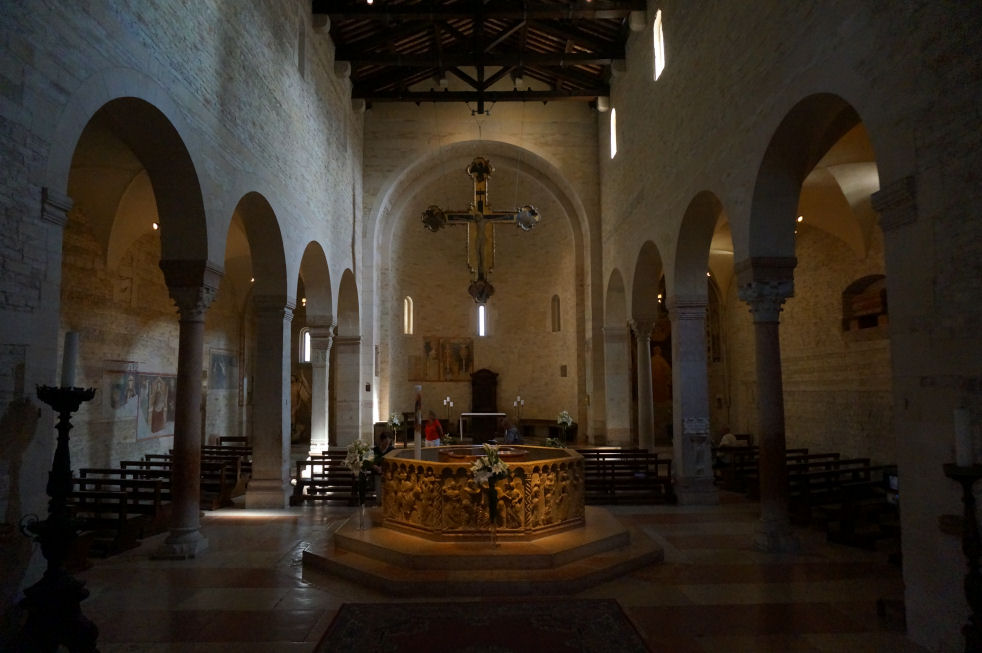|
|
 History HistoryThe first Christian basilica was built on the site currently occupied by the adjoining church of Sant'Elena. This first building was consecrated by St Zeno between 362 and 380, but it soon became too small and a larger basilica was built. Remains of the first of these early churches can be seen under St Elena, remains of the second can be seen beneath the cloister. This second building collapsed during the 7th century, possibly due to fire or earthquake, and the 8th-9th century (Carolingian) replacement was built on the site of the current church. This church was itself damaged by an earthquake in 1117 and a new one soon built, at the instigation of Bishop Bernardo, which was finally reconsecrated by Urban III on September 13th 1187. This church, the current building, was called Santa Maria Assunta and built further south than the previous churches, on the site of a church dedicated to Santa Maria Matricolare, of which no archaeological traces have been found.The interior was rebuilt in gothic style from 1444 into the 16th century when the aisle-divisions, side chapels and the choir screen were built.  Exterior ExteriorThe main doorway and its two-storey prothyrum is the work of Master Nicol˛, the 12th century sculptor who also carved the fašade of San Zeno and worked on the fašade of Ferrara's Duomo. Two arches containing sculptural reliefs are supported on columns with statues with griffins at the base. The two large Gothic windows either side were inserted during the 15th century work. The lunette features 13th-century polychroming and depicts The Annunciation to the Shepherds and The Adoration of the Magi with The Virgin and Child Enthroned in the centre. The side entrance porch (see the old print left) has sprightly work attributed to a 12th-century sculptor called Pelegrinus. Interior A nave and two aisles divided by tall columns of clusters of small columns in red Verona marble. This is a church with fewer side chapels than you'd think, because they're all big and each has lots of surrounding frescos conforming to a type representing monuments with statues. Also not the brightest church due to mostly small clerestory windows. The floor dates to 1880. The first chapel on the left, the Cartolari Nichesola, contains a somewhat restrained Assumption by Titian of c. 1530, his only work in Verona, it was looted by Napoleon, but was later returned and restored. It's not a patch on his earlier monumental Assumption in the Frari in Venice for complexity and dramatic colouring. The surrounding chapel (see below right) was renovated for the Nichesola family around the same time by Jacopo Sansovino, who is said to have been an intermediary in the purchase of Titian's altarpiece. The frescoes on the wall are late 14th century. The second chapel, the Abbazia-Lazzari, has late 14th century wall frescoes by Antonio Badile. The fourth chapel, the Chapel of the Madonna del Popolo, is deeper, almost making a baroque transept with the chapel opposite. It is a site of local popular veneration, housing a recent Madonna, made by Venetian sculptor Vincenzo Cadorin in 1920. It also has a reliquary urn containing the thorn with which local martyr saints Fermo and Rustico were killed. Just before this chapel is the (ever closed) door to the Sacristy of the Canons of 1625. The ceiling is decorated with a stucco scene depicting the patron of the Chapter, St. George Killing the Dragon, attributed to David Reti. The altarpiece is The Virgin and Child by Claudio Ridolfi.  The organ on this side is decorated with paintings by Felice Brusasorci - Four Veronese Bishops and a Dormition on the doors and Old Testament Stories on the balustrade. Under it is the door which opens into a Romanesque atrium of Santa Maria Matricolare which leads, straight on, into the church of Saint Elena and to the right, passing the toilets, to the Baptistery. Sant'Elena (see photo right) is reached by passing over the excavated remains of the early 4th-century basilica. Standing on the site of the original 4th-century church, Sant'Elena is a single nave space renovated after the earthquake of 1117. Most of the floor of the presbytery has been removed to reveal the mosaic floor of the earlier church. The altarpiece from 1579 depicts The Virgin and Child Enthroned with Saints Stephen, Zeno, George and Helen by Felice Brusasorci. The nave has 18th-century altars with contemporary altarpieces. The gallery at the back has worn trompe l'oeil balustrade. The outside wall has an inscription stating that Dante, here at the invittion of the Scaligers, read his first oration, the famous Question of Water and Earth (Quaestio de acqua et terra) beneath the 15th century portico here in 1320. The Baptistery, called San Giovanni in Fonte, (see photo below) was rebuilt around 1123 in Romanesque style on the site of the original 8th-9th century baptistery. It is basilical, with a nave and two aisles, unlike the usual central-planned shape of baptisteries. It is is dominated by a large 13th-century octagonal font made from red Verona marble, with eight carved scenes from the Annunciation to the Baptism of Christ. These panels are by two hands: Briolato, also responsible for the Wheel of Fortune window in San Zeno, and an anonymous master, whose style is more typically Venetian/Byzantine. There's a processional Crucifix here too, attributed to Giovanni Badile from c.1441, which was originally in Sant'Elena, and fresco fragments from the 13th and 14th centuries. Also a Virgin and Child Enthroned with Saints Stephen and Dionysius and a donor, signed an dated 1514 by Giovanni Caroto (the younger brother of the more famous Giovan Francesco) tucked away sharp into the back of the right-hand aisle. Also a large Baptism of Christ signed and dated 1568 by Paolo Farinati, now over the door, but originally on the high altar. It was moved to face the panel with the same subject on the font.  Back in the Cathedral, the apse (see right) has a semi-circular polychrome marble screen of Ionic columns, the tornacoro, designed by Michele Sanmicheli and commissioned by reforming Bishop Gian Matteo Ghiberti and foreshadowing the architectural influence of the Council of Trent. It dates to 1534, as do the trompe l'oeil frescoes by Francesco Torbido, depicting the Virgin and her Assumption, which were based on preparatory sketches by Giulio Romano. Back up the right hand side, the deep baroque chapel is the Memo Chapel and is followed by two chapels with fresco surrounds by Giovanni Maria Falconetto. The right-hand one of the pair, the Calcasoli chapel, (just past the cash desk) has a small Adoration of the Magi (c.1485) by Liberale da Verona, somewhat overpopulated and with a worrying mountain of pink putti behind the Virgin. It is surrounded in its frame by paintings of saints and an Entombment by Nicolo Giolfino. (You might read elsewhere that this chapel is dedicated to Saint Anthony of Vienna, but I can find no such saint.) The last chapel, opposite the Titian, has frescoes around it attributed to Antonio Badile. In front of its altarpiece is a somewhat gruesome little group of The Martyrdom of San Arcadio by sculptor Angelo Sartori.
Campanile Lost art |
|
|
|
|